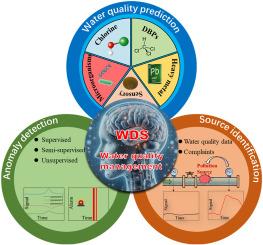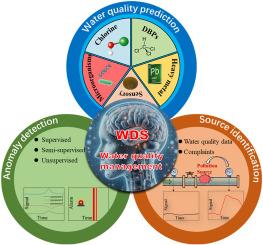Applications of machine learning in drinking water quality management: A critical review on water distribution system
IF 9.7
1区 环境科学与生态学
Q1 ENGINEERING, ENVIRONMENTAL
引用次数: 0
Abstract
As the final and crucial link in delivering clean water to consumers, the water distribution system faces the risk of water quality deterioration. Conventional water quality parameter monitoring and simple analysis may not adequately reflect complex changes in distribution. Machine learning (ML) excels at uncovering the intricate relationships among these. Although some reviews exist on ML in water resources, a systematic assessment of water quality in water distribution systems is lacking. The current review offers the first critical and comprehensive review of the application of ML in water quality management within water distribution systems, including water quality prediction, anomaly detection, and contamination source identification, and addresses the associated challenges and future directions. To be specific, for water quality prediction, the focus is on chlorine, disinfection by-products, microbial indicators, heavy metals, and sensory properties. The implementation of ML has the potential to reduce the cost of water quality monitoring and offer knowledge discovery. For anomaly detection, semi-supervised, supervised, and unsupervised models are reviewed. Changes in one or more surrogate water quality parameters measured by low-cost sensors can effectively indicate anomalous events. For contamination source identification, ML demonstrates its superiority in rapidly and accurately locating contamination sources. Additionally, dataset availability, interpretability, generalization capability, integrated models, real-time response and proactive decision have been identified as key areas for implementing ML. This review helps bridge the knowledge gap and provides a reference for the intelligent development of water quality management in distribution systems.


机器学习在饮用水质量管理中的应用:配水系统评述
作为向用户提供清洁水的最后一个关键环节,输水系统面临着水质恶化的风险。传统的水质参数监测和简单分析可能无法充分反映配水系统的复杂变化。机器学习 (ML) 擅长发现其中错综复杂的关系。虽然已有一些关于水资源中的 ML 的综述,但还缺乏对输水系统中水质的系统评估。本综述首次对人工智能在配水系统水质管理中的应用(包括水质预测、异常检测和污染源识别)进行了批判性的全面评述,并探讨了相关挑战和未来发展方向。具体而言,在水质预测方面,重点关注氯、消毒副产物、微生物指标、重金属和感官特性。采用 ML 有可能降低水质监测的成本,并提供知识发现。在异常检测方面,对半监督、监督和无监督模型进行了评述。低成本传感器测量到的一个或多个代用水质参数的变化可有效指示异常事件。在污染源识别方面,ML 在快速、准确地定位污染源方面显示出其优越性。此外,数据集的可用性、可解释性、概括能力、集成模型、实时响应和前瞻性决策已被确定为实施 ML 的关键领域。本综述有助于弥补知识差距,为配水系统水质管理的智能化发展提供参考。
本文章由计算机程序翻译,如有差异,请以英文原文为准。
求助全文
约1分钟内获得全文
求助全文
来源期刊

Journal of Cleaner Production
环境科学-工程:环境
CiteScore
20.40
自引率
9.00%
发文量
4720
审稿时长
111 days
期刊介绍:
The Journal of Cleaner Production is an international, transdisciplinary journal that addresses and discusses theoretical and practical Cleaner Production, Environmental, and Sustainability issues. It aims to help societies become more sustainable by focusing on the concept of 'Cleaner Production', which aims at preventing waste production and increasing efficiencies in energy, water, resources, and human capital use. The journal serves as a platform for corporations, governments, education institutions, regions, and societies to engage in discussions and research related to Cleaner Production, environmental, and sustainability practices.
 求助内容:
求助内容: 应助结果提醒方式:
应助结果提醒方式:


